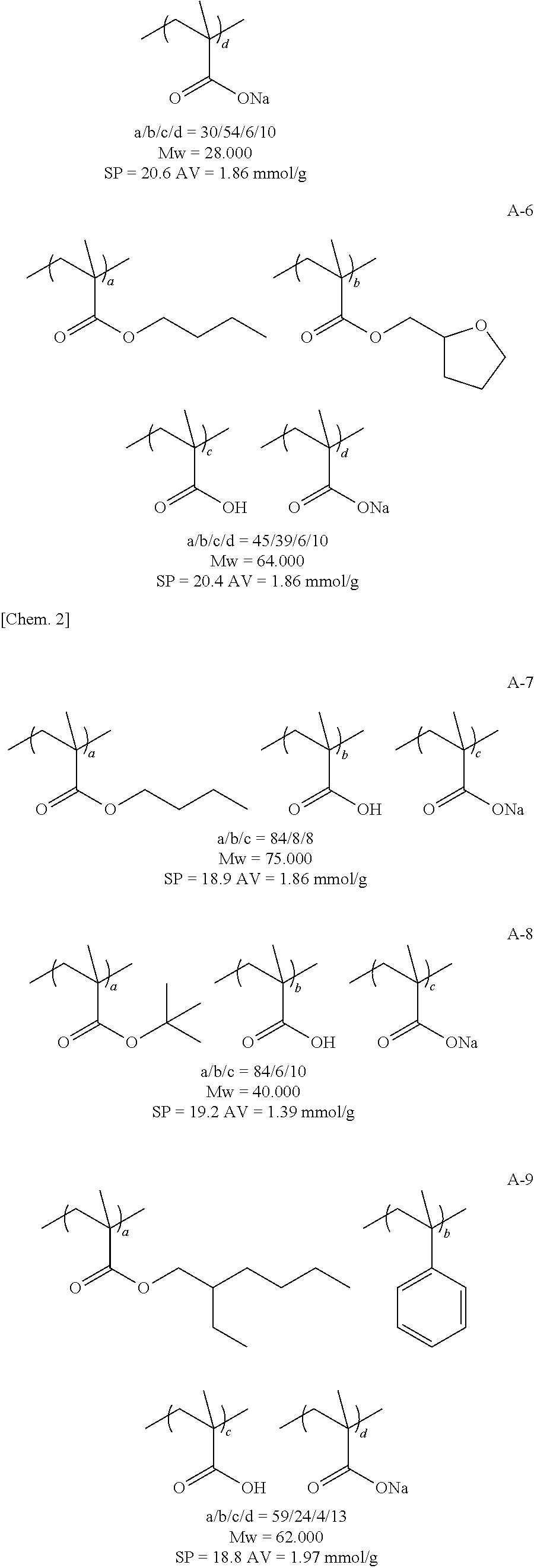Ink composition, image forming method, and printed article using the same
a technology of composition and image, applied in the field of composition and image forming methods, can solve the problems of insufficient image strength or glossiness of formed images, insufficient viscosity of composition using latex, and inability to further improve the bleeding of printed articles, etc., to achieve excellent adhesiveness, excellent toughness and glossiness
- Summary
- Abstract
- Description
- Claims
- Application Information
AI Technical Summary
Benefits of technology
Problems solved by technology
Method used
Image
Examples
synthesis example 1
Synthesis of Polymer Dispersant E-1
[0175]44 g of methyl ethyl ketone was put in a 500 ml three-neck flask including a stirrer and a condenser and heated at 72° C. under a nitrogen atmosphere, and a solution obtained by dissolving 0.43 g of dimethyl 2,2′-azobisisobutyrate, 30 g of benzyl methacrylate, 5 g of methacrylic acid, and 15 g of methyl methacrylate in 25 g of methyl ethyl ketone was added dropwise thereto over 3 hours. After the dropwise addition ended, the solution was reacted for an hour. Thereafter, a solution obtained by dissolving 0.21 g of dimethyl 2,2′-azobisisobutyrate in 1 g of methyl ethyl ketone was added thereto, and the temperature of the resultant was increased to 78° C. to perform heating for 4 hours. The obtained reaction solution was reprecipitated twice in an excess amount of hexane, and the precipitated resin was dried, thereby obtaining 43 g of a polymer dispersant E-1.
[0176]The composition of the obtained resin was confirmed by 1H-NMR, and the weight av...
synthesis example 2
Preparation of Dispersion of Resin-Coated Pigment
[0177](Resin-Coated Cyan Pigment Dispersion (C))
[0178]10 parts of Pigment Blue 15:3 (Phthalocyanine Blue A220 manufactured by Dainichiseika Color & Chemicals Mfg. Co., Ltd.), 5 parts of the polymer dispersant E-1 obtained in the Synthesis example 1, 42 parts of methyl ethyl ketone, 5.5 parts of a 1 mol / L aqueous NaOH solution, and 87.2 parts of deionized water were mixed together, and dispersed for 2 to 6 hours by a beads mill using 0.1 mmφ zirconia beads.
[0179]The obtained dispersion was heated at 55° C. under reduced pressure to remove methyl ethyl ketone and a portion of water, thereby obtaining a dispersion of a cyan pigment that was coated with the polymer dispersant E-1 and had a pigment concentration of 10.2% by mass. Hereinafter, the pigment dispersion will be called a “C dispersion”.
synthesis example 3
Synthesis of Comparative Water-Soluble Copolymer (B-1)
[0180]10.0 g of 2-butanone (manufactured by Wako Pure Chemical Industries, Ltd.) was put in a 200 mL three-neck flask including a stirring blade, and then stirred under heating for 10 minutes in an oil bath at 80° C. under a nitrogen atmosphere. Subsequently, a mixed solution of 24 g of n-butyl methacrylate (manufactured by Wako Pure Chemical Industries, Ltd.), 6.0 g of methacrylic acid (manufactured by Wako Pure Chemical Industries, Ltd.), 0.1 g of 6-mercaptohexanol (Sigma-Aldrich Co. LLC, Japan), 80 mg of dimethyl 2,2′-azobis(isobutyrate) (Wako Pure Chemical Industries, Ltd.), 30 g of 2-butanone, and 5 g of 2-propanol (Wako Pure Chemical Industries, Ltd.) was added dropwise for 3 hours to 2-butanone which was being heated under stirring in the flask. The solution was further stirred for 3 hours, and then 46 mg of dimethyl 2,2′-azobis(isobutyrate) was added thereto, followed by stirring with heating under reflux for 3 hours.
[01...
PUM
| Property | Measurement | Unit |
|---|---|---|
| Temperature | aaaaa | aaaaa |
| Fraction | aaaaa | aaaaa |
| Fraction | aaaaa | aaaaa |
Abstract
Description
Claims
Application Information
 Login to View More
Login to View More - R&D
- Intellectual Property
- Life Sciences
- Materials
- Tech Scout
- Unparalleled Data Quality
- Higher Quality Content
- 60% Fewer Hallucinations
Browse by: Latest US Patents, China's latest patents, Technical Efficacy Thesaurus, Application Domain, Technology Topic, Popular Technical Reports.
© 2025 PatSnap. All rights reserved.Legal|Privacy policy|Modern Slavery Act Transparency Statement|Sitemap|About US| Contact US: help@patsnap.com



